
Proactive Engagement: How Chicago’s Continuum of Care is Improving Connections to Permanent Supportive Housing

In 2023, a review of Chicago’s Permanent Supportive Housing1 (PSH) vacancy data indicated that 80% of units were occupied, with the remaining units sitting vacant while clients were identified, engaged, verified as eligible, and ultimately moved into a unit. With support from the Government Performance Lab, Chicago’s Continuum of Care2 (CoC) implemented a 12-month pilot to test several process changes to reduce vacant units and decrease the time it takes to go from referral to move-in.
Clients served under the pilot program had a referral success rate 33 percentage points higher than referrals made through the typical Coordinated Entry System3 (CES) pathway. On average, clients in the pilot moved into a unit 24 days faster than non-pilot clients. The GPL sat down with five Chicago stakeholders to ask about their experiences and early takeaways a year into implementing these changes.
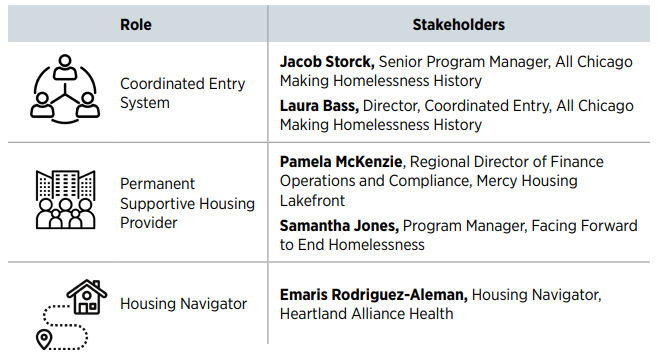
Defining the Problem
What is the main problem your organization is trying to address through this pilot? How would this pilot help clients?
Laura Bass, Director, Coordinated Entry: When All Chicago stepped into the Coordinated Entry lead role, one of the main things we wanted to understand was the referral success rate, or the number of referrals that result in a person moving into housing. Based on anecdotal feedback, we knew this number was low, but we didn’t have a mechanism for tracking that or beginning to address it.
Jacob Storck, Senior Program Manager, Coordinated Entry: There are a variety of factors for why PSH utilization is lower than we want it to be, including that a lot of referrals are unsuccessful due to not being able to contact participants, participants being ineligible for PSH, or not interested in a unit or a program. The focus of the pilot is to address those key areas for why referrals aren’t successful and to really do that in a targeted way to increase the success rate of referrals and improve our utilization as a system.
Pamela McKenzie, Housing Provider: Mercy Housing Lakefront is one of the largest providers of Permanent Supportive Housing within Chicago’s Continuum of Care. We’ve had challenges matching eligible, document-ready individuals with our vacant units. Despite how many individuals need housing, these units often remain unoccupied, which is a considerable inefficiency. Our goal is to streamline this process so we can minimize the burden on participants, ensuring that those in need can access housing more swiftly and efficiently.
Samantha Jones, Housing Provider: Facing Forward to End Homelessness got involved in the pilot because it is hard for us to fill our single room occupancy4 program units, and it is generally hard for us to reach the people referred to our units. People who are experiencing homelessness are difficult to contact and often don’t have their documentation ready to apply for and move into a unit. With this program, the housing navigators have really helped make sure clients are document ready, which has sped up the move-in process.
Emaris Rodriguez-Aleman, Housing Navigator: As housing navigators, we’re here to help people who need these services, but who often don’t have the full capability and understanding of the system to go through it on their own. We’re the extra support for people searching for housing and are here to show them that they do matter and that they do deserve housing.
Permanent Supportive Housing (PSH), which combines affordable housing with access to wraparound behavioral health services, is one of the most effective tools communities have at their disposal to address homelessness. However, the GPL’s research on PSH suggests that many locally-led Coordinated Entry Systems face barriers to efficiently placing eligible clients into these units,5 which leads to long referral timelines and unit vacancies.
In 2023, the GPL began working with Chicago’s Continuum of Care (CoC) to investigate drivers of PSH vacancies in their community. They wanted to test ways to reduce unit vacancies and move people into housing faster.
As the Coordinated Entry lead agency, All Chicago manages the PSH prioritization and referral process, oversees contracts with non-profits providing housing navigation services, and works with providers to move eligible residents into stable housing. The GPL worked with Chicago’s CoC to develop and test a set of practice changes in the referral process during a 12-month period from February 2024 to March 2025.
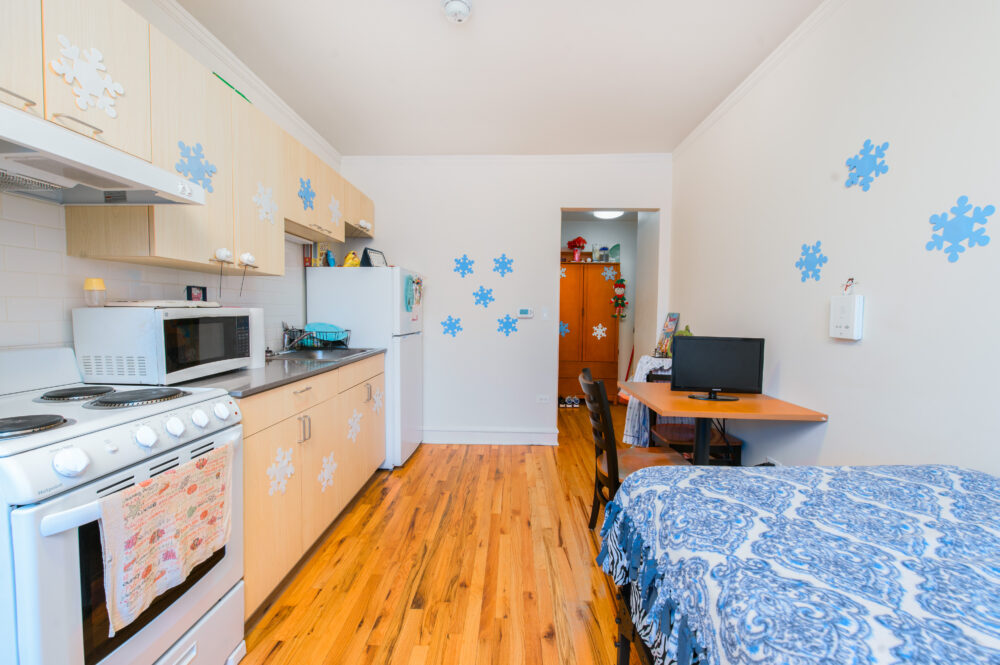
Designing a Pilot
The GPL performed a diagnostic analysis of your CoC’s data to inform the pilot’s design. What did this diagnostic process uncover?
Laura Bass, Director, Coordinated Entry: When the GPL did the diagnostic of our system data, our referral success rate was lower than I thought, which was upsetting. However, I think it’s important to be transparent and acknowledge that this is a baseline of where we’re starting from. It really backed up the idea that this is the data point we need to focus our efforts on and was our starting point in designing the process changes for the pilot.
Jacob Storck, Senior Program Manager, Coordinated Entry: The data analysis the GPL did was enormously helpful because that’s something that Continuums of Care don’t often have the capacity to do on the system level. Just seeing the percentage of referrals that were unsuccessful and having the data laid out in a direct way was really helpful. Through the diagnostic process, we identified that, of the projects that have high rematch rates, single room occupancy units are disproportionately represented compared to a one bedroom.
From February 2024 to March 2025, the Proactive Engagement Pilot tested new strategies to improve first-time referral success, reduce re-referrals, and shorten time-to-occupancy — with the goal of reducing the community’s PSH vacancy rate. Through the pilot, the GPL and All Chicago tested four process changes with a small group of PSH providers:
- Engaging Housing Navigators Earlier: In Chicago’s CoC, housing navigators are assigned after a client is referred, or matched, to a specific unit, often leading to failed matches due to outdated contact. The pilot tested whether involving navigators prior to matching a client to a unit could reduce failed referrals.
- Incorporating Client Preferences: Clients are only informed about PSH project details after being referred, and often the unit or program slot available does not match a participant’s housing needs or preferences. The pilot tested whether collecting client preferences and sharing unit info in advance could improve referral success.
- Gathering Documentation Proactively: Clients begin to gather the documents required for application and move-in only after they have been referred to a project, which can lead to move-in delays. The pilot tested whether navigator support collecting documents in the weeks before a person is referred to a unit could speed up the move-in process.
- Redesigning Case Conferencing: Provider attendance on large case conferencing calls is often low and client updates are instead often shared via email, making it difficult for stakeholders to receive timely updates on clients’ progress through the referral process. The pilot tested if smaller, focused sessions — including provider-specific calls and weekly housing navigator coordination meetings — can improve accountability and reduce delays.
How does the Proactive Engagement Pilot differ from your usual approach?
Jacob Storck, Senior Program Manager, Coordinated Entry: The pilot is significantly different from our typical referral process. Previously, when we were notified of available housing, we would pull our list of participants that were prioritized based on the community prioritization tool. We were not doing any proactive engagement or checking in with participants about their housing needs and preferences. Now, as part of the pilot, we are still identifying people who have completed the assessment and are prioritized for housing. Then, we assign them to a housing navigator for proactive engagement to specifically focus on addressing the typical reasons we see rematches in the housing process.
Laura Bass, Director, Coordinated Entry: The most common reason for an unsuccessful referral in our system is that the housing provider cannot locate the person. To some degree, that is a problem with having a waitlist — if you can’t give the person the thing they need when they come to you, it can be hard to stay in contact with them. The pilot changes don’t necessarily solve that problem, but it moves the burden of outreach to the navigators, who are better equipped to do that intensive outreach to look for folks.
Pamela McKenzie, Housing Provider: Having the housing navigators do the outreach under the proactive engagement approach allows everyone to focus on what they’re good at in the housing process. As a provider, we know how to house people, we don’t know how to do outreach. The more time we spend on unsuccessful outreach, the less time we are able to spend processing housing applications. I think it’s great that the burden of outreach has shifted to our partners in navigation who are better equipped to do it.
Emaris Rodriguez-Aleman, Housing Navigator: The navigators offer a lot more hands-on support for pilot participants. This includes explaining what to expect during intake appointments and helping participants gather documentation to apply for a project. We really go in-depth with participants to make sure they understand the housing they are being offered and are comfortable with what they are signing up for.
Project Information Sheets & Client Choice
As part of the pilot, the GPL helped compile “project information sheets” that centralize information about PSH units. These sheets are shared with clients and include photos of units, information on the location of a project, building amenities, and eligibility requirements. Clients are then able to express interest in specific buildings.
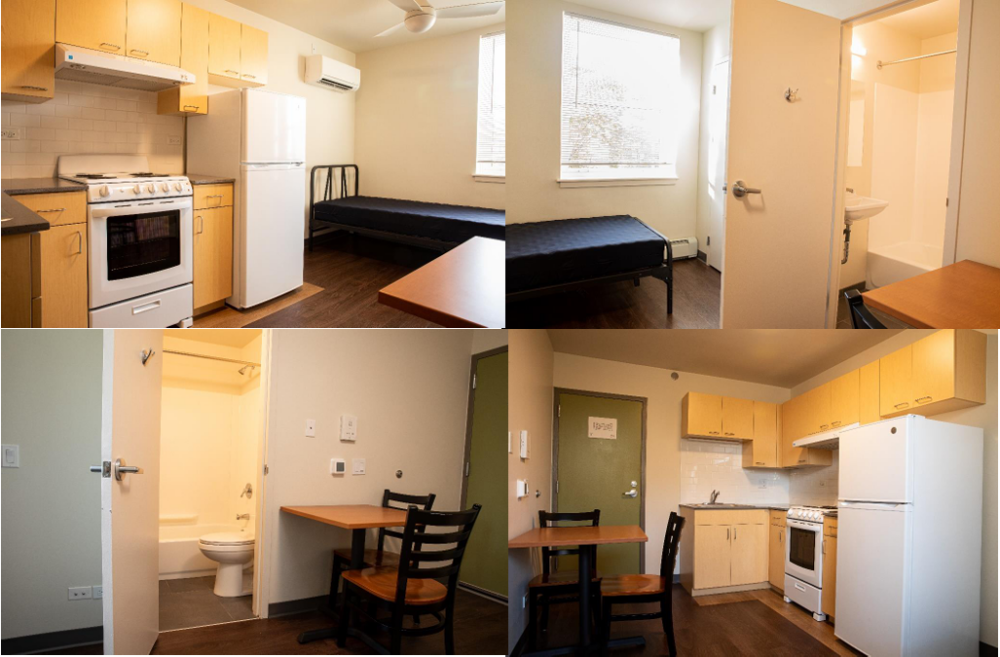
Jacob Storck, Senior Program Manager, Coordinated Entry: Although we are dealing with limited housing stock in Chicago, we believe that allowing client choice is important. To the extent that we can offer choices and be open and transparent about available housing options with participants, the more likely we will have a successful match and the client will have a positive experience. A lot of times what happens now is that somebody is referred to housing they’re not interested in, which delays the process and can also contribute to a sense of frustration with the system, or even a lack of trust.
Laura Bass, Director, Coordinated Entry: It has been helpful to have pictures of units and have really specific information about a project’s amenities. It isn’t that common for folks to decline PSH in our system, but when they do, it is almost always a single room occupancy efficiency unit. While we still have barriers with these types of units, the project information sheets give us the ability to be transparent that a large part of our housing stock is SROs and small studios. It allows us to have conversation about the tradeoffs of a person’s preference for a larger unit versus being housed quickly.
Pamela McKenzie, Housing Provider: It has been helpful to solicit participants’ preferences upfront instead of making a referral and having to do a rematch because an apartment isn’t a good fit. Part of elevating participant choice was to reduce rematches, and when I look at our data it does look like it’s having an impact. Giving clients a choice up front reduces inefficiencies in the system and offers people the respect and the dignity they deserve in the housing process by making them feel like they have some agency.
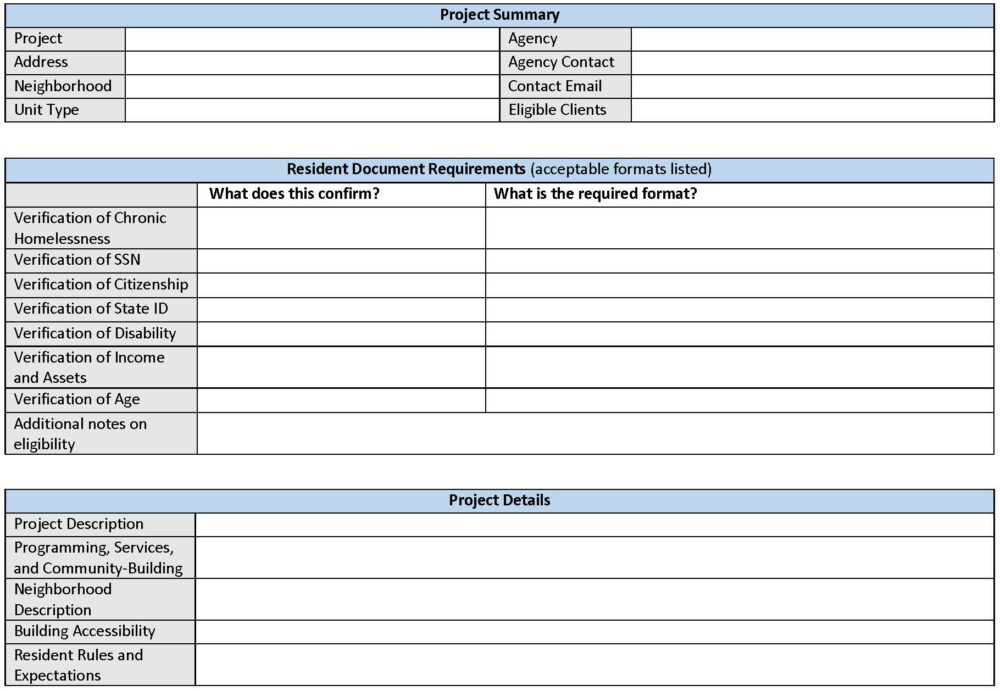
Running a Pilot
How has the pilot approach impacted the way providers, housing navigators, and All Chicago work together?
Laura Bass, Director, Coordinated Entry: I think the regular case conferencing has allowed us to problem-solve in real time. For example, it gives an opportunity for a provider to come to the meeting and say, “this person has been denied based on their background check,” then in the same meeting the navigator can ask about the appeals process and next steps. It allows us to be very solutions-focused and to figure out how to move someone through the referral process.
Pamela McKenzie, Housing Provider: The weekly case conference has been enormously helpful, and it has helped bring accountability to all of the partners. It’s a great way to quickly problem-solve and it has helped us build rapport between the housing providers and the navigators. We’re all on the same team trying to hold each other accountable and make progress collectively.
Emaris Rodriguez-Aleman, Housing Navigator: Prior to the proactive engagement pilot, you spoke to people via email, but you never put a face to them, and I think having regular in-person meetings has helped us build stronger, more collaborative relationships.
Samantha Jones, Housing Provider: It has been great to have a weekly meeting with All Chicago and the housing navigators to speak about specific application processes. We’re able to get important updates in a timely manner, it’s kind of like tracking a package you’re waiting for — you just want to have updates on where in the process a referral is.
Has proactive engagement changed the role of your system’s housing navigators?
Jacob Storck, Senior Program Manager, Coordinated Entry: Housing navigators tell us that the proactive engagement approach is gratifying because they’re able to see participants through the whole housing process — from getting someone’s housing preferences, to supporting them with documents, all the way to helping them move into a unit. We now meet with the navigators weekly to conference on issues that arise, which makes it easier for navigators to manage their caseloads. It has also created opportunities for the navigators to build relationships amongst themselves and to be able to share resources with each other.
Laura Bass, Director, Coordinated Entry: Having weekly meetings for the navigators has given us an opportunity to standardize knowledge across navigators and created a space where more seasoned navigators can share their knowledge about how to effectively move a referral through the system with newer staff.
Preliminary Results
What was the impact of the pilot?
During the 12-month period of the Proactive Engagement Pilot, 136 clients were successfully housed using the pilot process, comprising roughly 22% of all clients housed in PSH across Chicago’s Coordinated Entry System. Under the pilot, referred clients were both more likely to be housed and were housed faster compared to the entire system.
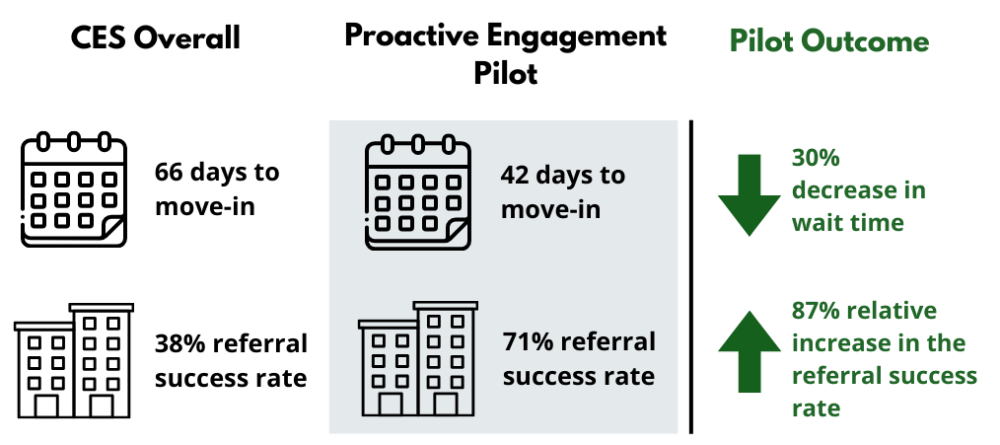
Based on this promising preliminary data, the Chicago CoC is now working to scale and implement the core practices of this model, including upstream navigation support, document collection, and case conferencing, across the system.
Key Takeaways
What have you learned about improving PSH referral processes through implementing the Proactive Engagement Pilot?
Samantha Jones, Housing Provider: It’s important to make sure eligibility is clear. People need to know what documents they need, what fees applications might have, and what the process will look like, so they’re prepared. The pilot approach has helped us communicate these expectations better with navigators and participants and has also helped us start troubleshooting issues with our property management. The documentation-ready aspect of this has also been a total game changer.
Laura Bass, Director, Coordinated Entry: We have learned that it is important to target our support to the group of people that are likely to be matched to housing soon. In our system, we assess about ten times more people than we have the capacity to house, so we’re talking about targeting limited resources like housing navigation for people who are at the top of the prioritization list. I also think that going through the diagnostic phase to understand the different barriers that participants or programs are experiencing and where referrals get stuck was really important.
Jacob Storck, Senior Program Manager, Coordinated Entry: We have monthly touch points that the GPL facilitates around PSH utilization data. We look at the matches from the past month and the success rate and drill down into the specifics of the reasons for rematches. This has allowed us to identify and name when there might be factors from other sectors that are intersecting with the work we’re trying to do, which is helpful because it is a big system. Being able to monitor data and identify if we’re seeing things that are changing from month to month is helpful.
Emaris Rodriguez-Aleman, Housing Navigator: The pilot taught me the importance of communicating with other parts of the system. One of the biggest strengths of the weekly meetings is that if I can’t contact a client, the odds are high that someone in that meeting will have additional resources or phone numbers of people for me to contact. Having more open communication has allowed us to leverage the strengths of our system partners.
Is there anything from the pilot that you hope to sustain or scale across your system?
Jacob Storck, Senior Program Manager, Coordinated Entry: We’re looking at improving the case conferencing structure to allow for more successful coordination between providers, building out project information sheets for each of our projects, and expanding proactive engagement with clients prior to matching them to a unit. Additionally, we are working with our Homeless Management Information System6 (HMIS) team to integrate the proactive engagement data needs into our HMIS.
Laura Bass, Director, Coordinated Entry: Because of the success we have seen through the pilot, we are now working to implement changes across our Coordinated Entry System, including the use of proactive engagement.
Samantha Jones, Housing Provider: This pilot has shown us that housing navigation is effective. If we are proactive in the housing referral process, we can get clients set up with a support system right away and help them stay involved in the housing process. With a housing navigator tied to a client, we increase our chances of being able to fill a unit and quickly move a client into housing.
Pamela McKenzie, Housing Provider: This pilot has proven what we already know: we need navigators, and they need to be better funded. You can build housing, but you can’t fill it without navigators. I think adopting the proactive engagement processes of this pilot on a broader scale and funding more navigators to do this work would be really effective across the board.
Notes
1Permanent Supportive Housing (PSH) is an effective and evidence-based solution that combines deeply affordable housing with integrated support services to reduce homelessness and improve behavioral health Numerous studies of PSH have found it successfully reduces homelessness and improves behavioral health outcomes, while also reducing costs across emergency systems, including jails, emergency rooms, and shelters.
2Continuums of Care (CoCs) are collaborative agencies comprised of local homeless response leaders and providers that administer federally fund- ed resources through Coordinated Entry
3Coordinated Entry Systems (CES) were introduced by the S. Department of Housing and Urban Development in 2009 to standardize the intake and prioritization process for distributing federally funded resources to ensure those most in need of support receive it.
4Single room occupancy (SRO) units are a common type of affordable housing that consists of small, individual rooms for one person, often with shared kitchens and bathrooms. In the pilot, all SROs had an in-unit kitchen and bathroom.
5The GPL’s research on Coordinated Entry Systems and Permanent Supportive Housing placement processes shows that many Continuums of Care face significant barriers to efficiently placing people in PSH, including limited access to real-time data, lengthy application processes with strict eligibility criteria, and limited staff capacity to drive system improvements. To learn more, please read: Coordinated Entry and Permanent Supportive Housing: A National Perspective on Barriers and Opportunities.
6Homeless Management Information Systems (HMIS) are technology systems used to collect data on the housing resources that individuals and families at risk of and experiencing homelessness access through a Continuum of Care.
More Research & Insights


Innovator Interview: Empowering families through place-based resource centers in Washington DC

Innovator Interview: Jennifer Birden, Connecticut Department of Children & Families

Innovator Interview: Lisa Morrison Butler, Chicago Department of Family and Support Services

Innovator Interview: Empowering families through place-based resource centers in Washington DC
